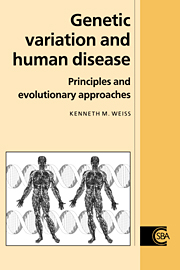Book contents
- Frontmatter
- Contents
- Frontispiece
- Preface: what is this book all about?
- Notational conventions used in this book
- List of abbreviations
- Part I Genes and their expression
- Part II Introduction to genetic epidemiology: inference from observational data
- 5 Segregation analysis: discrete traits in families
- 6 Segregation analysis: quantitative traits in families
- 7 Linkage analysis: finding and mapping genes for qualitative traits
- 8 Linkage analysis: finding and mapping genes for quantitative traits
- Part III Evolution: the time dimension in populations
- Part IV Modification of the inherited genotype: the time dimension in individuals
- Afterwords: towards a unified general model
- References
- Index
6 - Segregation analysis: quantitative traits in families
from Part II - Introduction to genetic epidemiology: inference from observational data
Published online by Cambridge University Press: 05 June 2012
- Frontmatter
- Contents
- Frontispiece
- Preface: what is this book all about?
- Notational conventions used in this book
- List of abbreviations
- Part I Genes and their expression
- Part II Introduction to genetic epidemiology: inference from observational data
- 5 Segregation analysis: discrete traits in families
- 6 Segregation analysis: quantitative traits in families
- 7 Linkage analysis: finding and mapping genes for qualitative traits
- 8 Linkage analysis: finding and mapping genes for quantitative traits
- Part III Evolution: the time dimension in populations
- Part IV Modification of the inherited genotype: the time dimension in individuals
- Afterwords: towards a unified general model
- References
- Index
Summary
One side will make you grow taller, and the other side will make you grow shorter. One side of what? The other side of what? thought Alice to herself.
L. Carroll, Alice in Wonderland (1865)The previous chapter dealt with the genetic basis of categorical phenotypes such as the presence or absence of a disease. But how do we assess the genetics of quantitative phenotypes that cannot be broken down into distinct categories? Such traits may be affected by a large number of loci acting together, as well as by environmental factors. Important diseaserelated traits such as blood pressure, obesity measures, or cholesterol and triglyceride levels are examples. For such traits, what we need to understand is the effect of the genotypes, and the environment, on the phenotype.
This chapter introduces many important concepts and models for quantitative traits {Crow and Kimura, 1970; Falconer, 1989; Hartl and Clark, 1989; Hedrick, 1985}. The material is rather dense and relentless, but the concepts are important to understand, as they enable us to look further at the genetic causal spectrum, and to decompose it into its constituent parts.
Einstein's trains: assigning phenotypic effects to genotypes
Allelic and genotypic values
Albert Einstein made himself famous by looking out of a train window and speculating as to why he could not tell whether his train was moving north or the train on the next track was moving south.
- Type
- Chapter
- Information
- Genetic Variation and Human DiseasePrinciples and Evolutionary Approaches, pp. 92 - 116Publisher: Cambridge University PressPrint publication year: 1993
- 1
- Cited by



